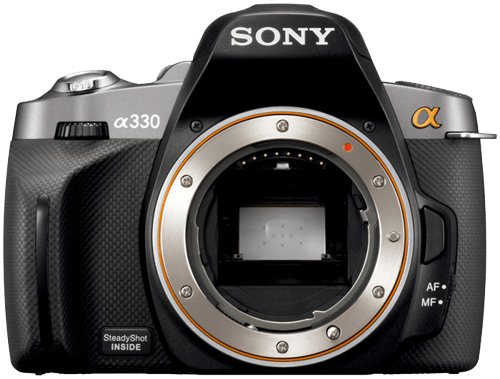Sony Alpha 330 Specs and Scores

The Sony Alpha 330 DSLR camera receives a score of 42/100. Launched in 2009 with a price of $780, it has been over a decade since its release. The camera’s dimensions are 128 x 97 x 71mm, and it weighs 529g (1.17lbs). In today’s market, the Alpha 330’s specifications fall behind more advanced models, as technology has significantly progressed since its debut. Despite its age, the Sony Alpha 330 still offers value for those seeking a basic DSLR camera.
Sony Alpha 330 Overview and Optics
The optics of the Sony Alpha 330 receive a score of 49/100. This camera features a 10.2-megapixel resolution, a 2.5 shooting speed, and a CCD sensor type. The Bionz processor and a DXOMARK score of 64 for the sensor contribute to its performance. With an APS-C sensor size and a Sony Alpha DT lens mount, the camera also provides image stabilization and a 3:2 aspect ratio.
In the current market, the Sony Alpha 330’s optics might not outshine newer models, as 10.2 megapixels and a 2.5 shooting speed are relatively low compared to contemporary cameras. However, the image stabilization feature and the 3:2 aspect ratio remain useful for various photography styles.
Considering the optics specifications, the Sony Alpha 330 may not be the top choice for professionals or enthusiasts seeking high-resolution images and faster shooting speeds. Nonetheless, it serves as a reliable option for beginner photographers or those prioritizing image stabilization and aspect ratio.
Sony Alpha 330 Video Performance
The Sony Alpha 330 lacks video capabilities. Unlike many modern cameras, it cannot record video. Its primary function is photography.
Sony Alpha 330 Features and Benefits
The Sony Alpha 330 receives a feature score of 34 out of 100. This score reflects the camera’s specifications, which include a 2.7-inch screen with a resolution of 230400 dots. Although the Alpha 330 does not have a touchscreen, it does have a flip screen that provides more flexibility when capturing photos from different angles.
In the current market, the lack of GPS, WIFI, and Bluetooth connectivity might be seen as a drawback for some users. These features have become standard in many modern cameras, allowing users to easily transfer and share images or geotag their photos.
The Sony Alpha 330’s features may not be the most competitive in today’s market. However, the flip screen and overall functionality make it a viable option for those who prioritize simplicity and ease of use over advanced connectivity options.
Sony Alpha 330 Storage and Battery
The Sony Alpha 330 receives a storage and battery score of 13/100. It has one memory card slot, compatible with both SD/SDHC and Memory Stick Pro Duo/Pro-HG Duo cards. However, having only one slot may limit storage capacity for users. The battery life of this camera is 230 shots, powered by an NP-FH50 battery. USB charging is not available for this model.
Compared to current market standards, the storage and battery capabilities of the Sony Alpha 330 might not satisfy the needs of modern photographers. The limited battery life and lack of USB charging may cause inconvenience during prolonged shooting sessions.
